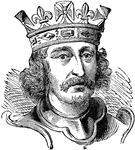Clipart tagged: ‘Richard I’

The Last Crusade
"Richard I (looking down on the Holy City): 'My dream comes true.' A cartoon which appeared in Punch,…

Crystal Palace Side View
A statue of Richard I sits outside the western entrance to the Crystal Palace. People are walking around…

Richard I of England
Richard I (8 September 1157 – 6 April 1199) was King of England from 6 July 1189 until his death.…

King Richard I
King of England from 1189 to 1199. He was often referred to as Richard the Lionheart.